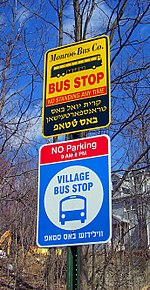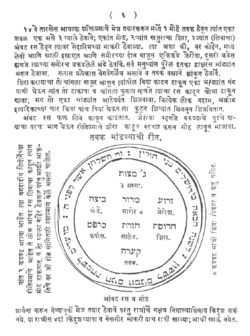Jewish languages
| Part of a series on |
| Jews and Judaism |
|---|
| Part of a series on |
| Jewish culture |
|---|
 |
| Judaism portal |
Jewish languages are the various
Ancient history
Early
The earliest distinctively Hebrew writing yet discovered was found at Khirbet Qeiyafa and dates to the 10th century BCE.[4][5] The Israelite tribes established a kingdom in Canaan at the beginning of the first millennium BCE, which later split into the Kingdom of Israel in the north and the Kingdom of Judah in the south after a dispute of succession.[6]
The kingdom of Israel was destroyed by the
Development of Jewish varieties of languages
Jewish communities were dispersed around the world in the diaspora which followed the Jewish-Roman wars. Some adopted the languages of their neighbors, but many developed new varieties of these languages, collectively termed "Jewish languages".
In the early 20th century, secularism among Jews and large population shifts prompted the beginning of a shift from Jewish to non-Jewish languages. Even so, the majority of Jews in
Classification
Jewish languages are generally defined as the unique linguistic
Some Jewish languages show the effects of the history of language shift among the speakers, including Hebrew-Aramaic influence. Yiddish exemplifies such a language. Some Jewish languages may become marked as distinctively Jewish because some shift affected some parts of the language as a whole. For example, what is today known as Baghdad Jewish Arabic (because it is the Arabic variety that was up until recently spoken by Baghdad's Jews) was originally the Arabic dialect of Baghdad itself and was used by all religious groups in Baghdad, but the Muslim residents of Baghdad later adopted Bedouin dialects of Arabic. Similarly, a dialect may be perceived as Jewish because its Jewish speakers brought the dialect of another region with them when they were displaced. In some cases, this may cause a dialect to be perceived as "Jewish" in some regions but not in others.
Some Jewish language varieties may not be
In some cases, as with Ladino, a register may be developed for Biblical translation and exegesis in which Hebrew-Aramaic patterns are frequently
Judaeo-Papiamento, the only living Jewish ethnolect endemic to the Americas and likely the only one that is also a creole language, has lexical differences from its non-Jewish counterpart that go beyond the influence of Hebrew and Aramaic. In formal contexts, Sephardic Jewish speakers of Papiamento tend to use extensive borrowing from French and Portuguese, whereas non-Jewish Curaçaoans mostly use Spanish loanwords in similar contexts.[15]

Status
Among the most widely spoken Jewish languages to develop in the diaspora are
Many ancient and distinct Jewish languages, including
Yiddish was the language spoken by the largest number of Jews in the 1850s, but today the three most commonly spoken languages among Jews are English, modern Hebrew, and Russian—in that order.[18] Yiddish, as well as several other Jewish languages, has contributed to the vocabulary of coterritorial non-Jewish languages, such as English or French.[19]
Radio Exterior de España, Spain's international public broadcaster, provides programming in Ladino, which they refer to as Sefardi.[20]
In the United States as well as in Birobidzhan, Russia, there are some local radio programs in Yiddish.
Judeo-Marathi (Marathi: जुदाव मराठी) is a form of Marathi spoken by the Bene Israel, a Jewish ethnic group that developed a unique identity in India. Judeo-Marathi, like other Marathi dialects, is written in the Devanagari script. It may not be sufficiently different from Marathi as to constitute a distinct language, although it is characterized by a number of loanwords from Hebrew and Aramaic as a result of influence from the Cochin Jewish community, as well as from Judeo-Malayalam, Portuguese and also some influence from the Urdu language.
Alphabets

For centuries Jews worldwide spoke the local or dominant languages of the regions they migrated to, often developing distinctive dialectal forms or branching off as independent languages. The usual course of development for these languages was through the addition of Hebrew words and phrases used to express uniquely Jewish concepts and concerns. Often they were written in Hebrew letters, including the block letters used in Hebrew today and Rashi script.
Conversely, Ladino, formerly written in Rashi script or Solitreo, since the 1920s is usually written in Turkey in the Latin alphabet with a spelling similar to that of Turkish, and has been occasionally printed in the Greek and Cyrillic alphabets.[21]
Also, some Yiddish-speakers have adopted the use of the Latin alphabet, in place of the Hebrew alphabet. This is predominantly to enable communications over the internet, without the need for special Hebrew keyboards.
References
- ^ Waltke & O'Connor (1990:6–7)
- ^ Waltke & O'Connor (1990:8–9)
- ^ Sáenz-Badillos (1993:1–2)
- ^ Feldman (2010)
- ^ Shanks (2010)
- ^ a b c d e Steiner (1997:145)
- ^ a b c Sáenz-Badillos (1993:112–113)
- ^ a b c d e f g Handbook of Jewish Languages
- ^ Sáenz-Badillos (1993:166, 171)
- ISBN 9781403938695.
- ^ YIDDISH: History and Development
- ^ Miller, Tori (November 18, 2019). "Yiddish on the Rise". University of Texas. Retrieved Nov 4, 2023.
- ^ Smith, Noah (September 30, 2022). "The pandemic and apps are fueling a surge of interest in Yiddish". Washington Post. Retrieved Nov 4, 2023.
- ^ A Short History of the Hebrew Language: Hebrew in the Diaspora
- Forverts(in Yiddish). Retrieved 2023-06-26.
- S2CID 243838176.
- Beth Hatefutsoth, The Nahum Goldmann Museum of the Jewish Diaspora. Archived from the originalon 2008-07-25. Retrieved 2008-07-03.
- ^ For Yiddish loanwords in French, see P. Nahon, « Notes lexicologiques sur des interférences entre yidich et français moderne », Revue de linguistique romane 81, 2017, p. 139-155.
- ^ REE programs in Ladino
- ^ Verba Hispanica X: Los problemas del estudio de la lengua sefardí Archived 2008-04-07 at the Wayback Machine, Katja Smid, Ljubljana, pages 113–124: Es interesante el hecho que en Bulgaria se imprimieron unas pocas publicaciones en alfabeto cirílico búlgaro y en Grecia en alfabeto griego. [...] Nezirović (1992: 128) anota que también en Bosnia se ha encontrado un documento en que la lengua sefardí está escrita en alfabeto cirilico. The Nezirović reference is: Nezirović, M., Jevrejsko-Spanjolska knjitévnost. Institut za knjifevnost, Svjeálost, Sarajevo, 1992.
Bibliography
- Feldman, Rachel (2010). "Most ancient Hebrew biblical inscription deciphered". Archived from the original on 7 June 2011. Retrieved 15 June 2011.
- Kahn, Lily; Rubin, Aaron D. (2016). Handbook of Jewish Languages. Leiden: Brill. ISBN 9789004345775.
- Sáenz-Badillos, Angel (1993). A History of the Hebrew Language. Cambridge University Press. ISBN 0-521-55634-1.
- Shanks, Hershel (2010). "Oldest Hebrew Inscription Discovered in Israelite Fort on Philistine Border". Biblical Archaeology Review. 36 (2): 51–6. Archived from the original on 2019-06-02. Retrieved 21 December 2021.
- Steiner, Richard C. (1997), "Ancient Hebrew", in Hetzron, Robert (ed.), The Semitic Languages, Routledge, pp. 145–173, ISBN 0-415-05767-1
- Waltke, Bruce K.; O'Connor, M. (1990). An Introduction to Biblical Hebrew Syntax. Winona Lake, Indiana: Eisenbrauns. ISBN 0-931464-31-5.
- Zuckermann, Ghil'ad (ed.) 2014. Jewish Language Contact (International Journal of the Sociology of Language 226)
